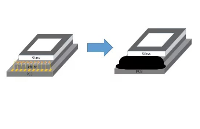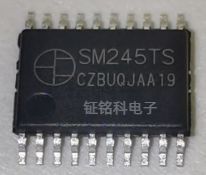【摘要】 OLED顯示屏在是智能手環(huán),智能手表上用的非常的多,功耗低,不刺眼,優(yōu)點特別多。本篇文章就介紹,在Linux系統(tǒng)里如何使用OLED顯示屏,要使用OLED顯示屏,大致分為兩步: (1) 針對OLED顯示屏編寫一個驅(qū)動 (2) 編寫應用層程序進行測試。
1. 前言
OLED顯示屏在是智能手環(huán),智能手表上用的非常的多,功耗低,不刺眼,優(yōu)點特別多。本篇文章就介紹,在Linux系統(tǒng)里如何使用OLED顯示屏,要使用OLED顯示屏,大致分為兩步: (1) 針對OLED顯示屏編寫一個驅(qū)動 (2) 編寫應用層程序進行測試。
采用的OLED顯示屏是0.96寸SPI接口顯示屏,分辨率是128*64,比較便宜,淘寶上非常多。
測試開發(fā)板采用友善之臂Tiny4412,三星的EXYNOS-4412芯片,4核1.5GHZ,板載8G-EMMC,2G-DDR。
2. 硬件接線效果




3. 驅(qū)動代碼
Linux內(nèi)核提供了標準SPI子系統(tǒng)框架,和前面介紹的IIC子系統(tǒng)框架使用類似,代碼分為設(shè)備端和驅(qū)動端,Linux內(nèi)核提供子系統(tǒng)的目的就是為了統(tǒng)一驅(qū)動編寫標準,提高驅(qū)動代碼的移植性。
本篇文章代碼沒有采用SPI子系統(tǒng)框架,采用單片機慣用的模擬SPI時序,對入門而言,代碼更容易理解。
3.1 oled.c 驅(qū)動示例代碼
#include
#include
#include
#include
#include
#include
#include
#include
#include
#include
#include
#include
#include
/*
定義OLED需要使用的寄存器
*/
static volatile unsigned int *GPB_CON=NULL;
static volatile unsigned int *GPB_DAT=NULL;
//OLED屏幕底層接口
#define OLED_SCK(x) if(x){*GPB_DAT|=1<<0;}else{*GPB_DAT&=~(1<<0);}
#define OLED_MOSI(x) if(x){*GPB_DAT|=1<<3;}else{*GPB_DAT&=~(1<<3);}
#define OLED_RES(x) if(x){*GPB_DAT|=1<<4;}else{*GPB_DAT&=~(1<<4);}
#define OLED_DC(x) if(x){*GPB_DAT|=1<<5;}else{*GPB_DAT&=~(1<<5);}
#define OLED_CS(x) if(x){*GPB_DAT|=1<<1;}else{*GPB_DAT&=~(1<<1);}
//命令與數(shù)據(jù)區(qū)分
#define OLED_CMD 0
#define OLED_DAT 1
//函數(shù)聲明區(qū)域
static void OLED_WriteOneByte(u8 data,u8 cmd);
static u8 OLED_GPIO_Init(void);
static void OLED_Init(void);
static void OLED_Clear(u8 data);
static void OLED_DrawPoint(u8 x,u8 y,u8 c);
static void OLED_RefreshGRAM(void);
/*
函數(shù)功能: OLED對應的GPIO口初始化
硬件連接:
OLED模塊---Tiny4412開發(fā)板
GND--------GND
VCC--------VCC(5V)
D0---------SCL--------------GPB_0
D1---------MOSI-------------GPB_3
RES--------復位-------------GPB_4
DC---------數(shù)據(jù)/命令--------GPB_5
CS---------CS片選-----------GPB_1
*/
static u8 OLED_GPIO_Init(void)
{
/*1. 將物理地址轉(zhuǎn)換為虛擬地址*/
GPB_CON=ioremap(0x11400040,4);
GPB_DAT=ioremap(0x11400044,4);
if(GPB_CON==NULL||GPB_DAT==NULL)
{
printk("物理地址轉(zhuǎn)換為虛擬地址出現(xiàn)問題!\n");
return -1;
}
/*2. 配置GPIO口模式*/
*GPB_CON&=0xFF000F00;
*GPB_CON|=0x00111011;
/*3. 上拉GPIO口*/
OLED_CS(1);
OLED_DC(1);
OLED_MOSI(1);
OLED_RES(1);
OLED_SCK(1);
}
/*
函數(shù)功能: OLED屏幕初始化
*/
static void OLED_Init(void)
{
/*1. 初始化配置GPIO口*/
OLED_GPIO_Init();
/*2. 執(zhí)行OLED屏幕的初始化配置*/
OLED_RES(1);
udelay(2000);
OLED_RES(0);
udelay(2000);
OLED_RES(1);
udelay(2000);
OLED_WriteOneByte(0xAE,OLED_CMD); //0xAE表示關(guān)顯示,0xAF表示開顯示
OLED_WriteOneByte(0x00,OLED_CMD);
OLED_WriteOneByte(0x10,OLED_CMD);
OLED_WriteOneByte(0x40,OLED_CMD);
OLED_WriteOneByte(0xB0,OLED_CMD);
OLED_WriteOneByte(0x81,OLED_CMD);
OLED_WriteOneByte(0xCF,OLED_CMD);
OLED_WriteOneByte(0xA1,OLED_CMD);
OLED_WriteOneByte(0xA6,OLED_CMD);
OLED_WriteOneByte(0xA8,OLED_CMD);
OLED_WriteOneByte(0x3F,OLED_CMD);
OLED_WriteOneByte(0xC8,OLED_CMD);
OLED_WriteOneByte(0xD3,OLED_CMD);
OLED_WriteOneByte(0x00,OLED_CMD);
OLED_WriteOneByte(0xD5,OLED_CMD);
OLED_WriteOneByte(0x80,OLED_CMD);
OLED_WriteOneByte(0xD9,OLED_CMD);
OLED_WriteOneByte(0xF1,OLED_CMD);
OLED_WriteOneByte(0xDA,OLED_CMD);
OLED_WriteOneByte(0x12,OLED_CMD);
OLED_WriteOneByte(0xDB,OLED_CMD);
OLED_WriteOneByte(0x30,OLED_CMD);
OLED_WriteOneByte(0x8D,OLED_CMD);
OLED_WriteOneByte(0x14,OLED_CMD);
OLED_WriteOneByte(0xAF,OLED_CMD); //正常模式
}
/*
函數(shù)功能: 寫一個字節(jié)
函數(shù)參數(shù):
cmd=0表示命令,cmd=1表示數(shù)據(jù)
*/
static void OLED_WriteOneByte(u8 data,u8 cmd)
{
u8 i;
/*1. 區(qū)分發(fā)送數(shù)據(jù)是命令還是屏幕數(shù)據(jù)*/
if(cmd){OLED_DC(1);}
else {OLED_DC(0);}
udelay(2);
/*2. 發(fā)送實際的數(shù)據(jù)*/
OLED_CS(0); //選中OLED
for(i=0;i<8;i++)
{
udelay(2);
OLED_SCK(0); //告訴從機,主機將要發(fā)送數(shù)據(jù)
if(data&0x80){OLED_MOSI(1);} //發(fā)送數(shù)據(jù)
else {OLED_MOSI(0);}
udelay(2);
OLED_SCK(1); //告訴從機,主機數(shù)據(jù)發(fā)送完畢
data<<=1; //繼續(xù)發(fā)送下一位數(shù)據(jù)
}
OLED_CS(1); //取消選中OLED
OLED_SCK(1); //上拉時鐘線,恢復空閑電平
}
/*
函數(shù)功能: 清屏 (開全部燈、關(guān)全部燈)
*/
static void OLED_Clear(u8 data)
{
u8 i,j;
for(i=0;i<8;i++)
{
OLED_WriteOneByte(0xB0+i,OLED_CMD); //設(shè)置頁地址
OLED_WriteOneByte(0x10,OLED_CMD); //設(shè)置列高起始地址(半字節(jié))
OLED_WriteOneByte(0x00,OLED_CMD); //設(shè)置列低起始地址(半字節(jié))
for(j=0;j<128;j++)
{
OLED_WriteOneByte(data,OLED_DAT); //寫數(shù)據(jù)
}
}
}
/*
定義顯存數(shù)組: 8行,每行128列,與OLED屏幕對應
*/
static u8 OLED_GRAM[8][128];
/*
函數(shù)功能: 畫點函數(shù)
x: 橫向坐標0~128
y: 縱坐標0~64
c: 1表示亮、0表示滅
*/
static void OLED_DrawPoint(u8 x,u8 y,u8 c)
{
u8 page;
page=y/8; //得到當前點的頁數(shù)0/8=0 1/8=0
y=y%8; //得到一列中點的位置。(0~7)
//0%8=0 1%8=1 .....7%8=7 8%8=0 9%8=1 ......
if(c) OLED_GRAM[page][x]|=1vm_flags |= VM_RESERVED;//標志該內(nèi)存區(qū)不能被換出,在設(shè)備驅(qū)動中虛擬頁和物理頁的關(guān)系應該是長期的,應該保留起來,不能隨便被別的虛擬頁換出
if(remap_pfn_range(vma,//虛擬內(nèi)存區(qū)域,即設(shè)備地址將要映射到這里
vma->vm_start,//虛擬空間的起始地址
virt_to_phys(mmap_buffer)>>PAGE_SHIFT,//與物理內(nèi)存對應的頁幀號,物理地址右移 12 位
vma->vm_end - vma->vm_start,//映射區(qū)域大小,一般是頁大小的整數(shù)倍
vma->vm_page_prot))//保護屬性,
{
return -EAGAIN;
}
printk("(drv)映射的長度:%d\n",vma->vm_end - vma->vm_start);
printk("物理地址:0x%X\n",virt_to_phys(mmap_buffer));
/*
開發(fā)板的DDR容量: 1G
0x40000000 ~ 0x80000000
0x10000000=256M
*/
return 0;
}
#define _OLED_RefreshGRAM 0x12345 /*將應用層的數(shù)據(jù)刷新到OLED屏幕上*/
#define _OLED_ClearGRAM 0x45678 /*將應用層的數(shù)據(jù)刷新到OLED屏幕上*/
static int lcd_ioctl(struct fb_info *info, unsigned int cmd,unsigned long arg)
{
switch(cmd)
{
case _OLED_RefreshGRAM:
memcpy(OLED_GRAM,mmap_buffer,1024); //拷貝數(shù)據(jù)
OLED_RefreshGRAM(); /*刷新*/
break;
case _OLED_ClearGRAM: /*清屏*/
OLED_Clear(0);
break;
}
return 0;
}
static int lcd_release(struct fb_info *info, int user)
{
if(mmap_buffer!=NULL)
{
kfree(mmap_buffer);
}
printk("lcd_release調(diào)用成功\n");
return 0;
}
/*幀緩沖設(shè)備專用的文件操作接口*/
static struct fb_ops fbops=
{
.fb_open=lcd_open,
.fb_release=lcd_release,
.fb_mmap=lcd_mmap,
.fb_ioctl=lcd_ioctl
};
/*幀緩沖的設(shè)備結(jié)構(gòu)體*/
static struct fb_info lcd_info=
{
.var= /*可變形參*/
{
.xres=128,
.yres=64,
.bits_per_pixel=1
},
.fix=
{
.smem_len=4096,
.line_length=128
},
.fbops=&fbops
};
static int __init tiny4412_oled_init(void)
{
/*1. 初始化OLED屏幕*/
OLED_Init();
OLED_Clear(0);//清屏為黑色
/*2. 幀緩沖驅(qū)動注冊*/
if(register_framebuffer(&lcd_info)!=0)
{
printk("提示: lcd驅(qū)動安裝失敗!\n");
return -1;
}
else
{
printk("提示: lcd驅(qū)動安裝成功!\n");
}
return 0;
}
static void __exit tiny4412_oled_exit(void)
{
/*1. 幀緩沖驅(qū)動注銷*/
if(unregister_framebuffer(&lcd_info)!=0)
{
printk("提示: lcd驅(qū)動卸載失敗!\n");
return -1;
}
else
{
printk("提示: lcd驅(qū)動卸載成功!\n");
}
/*2. 解除虛擬地址映射關(guān)系*/
iounmap(GPB_CON);
iounmap(GPB_DAT);
}
module_init(tiny4412_oled_init); /*指定驅(qū)動的入口函數(shù)*/
module_exit(tiny4412_oled_exit); /*指定驅(qū)動的出口函數(shù)*/
MODULE_LICENSE("GPL"); /*指定驅(qū)動許可證*/
;>
3.2 app.c 應用層代碼
#include
#include
#include
#include
#include
#include
#include
unsigned char *lcd_mem=NULL; /*LCD的內(nèi)存地址*/
struct fb_fix_screeninfo finfo; /*固定形參*/
struct fb_var_screeninfo vinfo; /*可變形參*/
unsigned char font[]=
{
/*-- 文字: 國 --*/
/*-- 宋體42; 此字體下對應的點陣為:寬x高=56x56 寬/8*高*/
0x00,0x00,0x00,0x00,0x00,0x00,0x00,0x00,0x00,0x00,0x00,0x00,0x00,0x00,0x00,0x00,
0x00,0x00,0x00,0x00,0x00,0x01,0xC0,0x00,0x00,0x00,0x07,0x00,0x01,0xFF,0xFF,0xFF,
0xFF,0xFF,0xC0,0x01,0xFF,0xFF,0xFF,0xFF,0xFF,0xE0,0x01,0xF0,0x00,0x00,0x00,0x07,
0xC0,0x01,0xF0,0x00,0x00,0x00,0x07,0x80,0x01,0xF0,0x00,0x00,0x00,0x07,0x80,0x01,
0xF0,0x00,0x00,0x01,0x87,0x80,0x01,0xF0,0x00,0x00,0x03,0xC7,0x80,0x01,0xF7,0xFF,
0xFF,0xFF,0xE7,0x80,0x01,0xF3,0xFF,0xFF,0xFF,0xF7,0x80,0x01,0xF1,0xC0,0x7C,0x00,
0x07,0x80,0x01,0xF0,0x00,0x7C,0x00,0x07,0x80,0x01,0xF0,0x00,0x7C,0x00,0x07,0x80,
0x01,0xF0,0x00,0x7C,0x00,0x07,0x80,0x01,0xF0,0x00,0x7C,0x00,0x07,0x80,0x01,0xF0,
0x00,0x7C,0x00,0x07,0x80,0x01,0xF0,0x00,0x7C,0x00,0x07,0x80,0x01,0xF0,0x00,0x7C,
0x00,0x07,0x80,0x01,0xF0,0x00,0x7C,0x06,0x07,0x80,0x01,0xF0,0x00,0x7C,0x0F,0x07,
0x80,0x01,0xF1,0xFF,0xFF,0xFF,0x87,0x80,0x01,0xF1,0xFF,0xFF,0xFF,0xC7,0x80,0x01,
0xF0,0xF0,0x7C,0x00,0x07,0x80,0x01,0xF0,0x00,0x7C,0x00,0x07,0x80,0x01,0xF0,0x00,
0x7F,0xC0,0x07,0x80,0x01,0xF0,0x00,0x7D,0xF0,0x07,0x80,0x01,0xF0,0x00,0x7C,0xFC,
0x07,0x80,0x01,0xF0,0x00,0x7C,0x7E,0x07,0x80,0x01,0xF0,0x00,0x7C,0x3F,0x07,0x80,
0x01,0xF0,0x00,0x7C,0x3F,0x07,0x80,0x01,0xF0,0x00,0x7C,0x1F,0x07,0x80,0x01,0xF0,
0x00,0x7C,0x0F,0x07,0x80,0x01,0xF0,0x00,0x7C,0x0E,0x07,0x80,0x01,0xF0,0x00,0x7C,
0x07,0x87,0x80,0x01,0xF0,0x00,0x7C,0x03,0xC7,0x80,0x01,0xF0,0x00,0x7C,0x07,0xE7,
0x80,0x01,0xFF,0xFF,0xFF,0xFF,0xF7,0x80,0x01,0xFF,0xFF,0xFF,0xFF,0xFF,0x80,0x01,
0xF7,0x80,0x00,0x00,0x07,0x80,0x01,0xF0,0x00,0x00,0x00,0x07,0x80,0x01,0xF0,0x00,
0x00,0x00,0x07,0x80,0x01,0xF0,0x00,0x00,0x00,0x07,0x80,0x01,0xF0,0x00,0x00,0x00,
0x07,0x80,0x01,0xFF,0xFF,0xFF,0xFF,0xFF,0x80,0x01,0xFF,0xFF,0xFF,0xFF,0xFF,0x80,
0x01,0xF0,0x00,0x00,0x00,0x07,0x80,0x01,0xF0,0x00,0x00,0x00,0x07,0x80,0x01,0xF0,
0x00,0x00,0x00,0x07,0x80,0x01,0xF0,0x00,0x00,0x00,0x07,0x00,0x01,0xC0,0x00,0x00,
0x00,0x00,0x00,0x00,0x00,0x00,0x00,0x00,0x00,0x00,0x00,0x00,0x00,0x00,0x00,0x00,
0x00,0x00,0x00,0x00,0x00,0x00,0x00,0x00,
};
/*
定義顯存數(shù)組: 8行,每行128列,與OLED屏幕對應
*/
static unsigned char OLED_GRAM[8][128];
/*
函數(shù)功能: 畫點函數(shù)
x: 橫向坐標0~128
y: 縱坐標0~64
c: 1表示亮、0表示滅
*/
static void OLED_DrawPoint(unsigned char x,unsigned char y,unsigned char c)
{
unsigned char page;
page=y/8; //得到當前點的頁數(shù)0/8=0 1/8=0
y=y%8; //得到一列中點的位置。(0~7)
//0%8=0 1%8=1 .....7%8=7 8%8=0 9%8=1 ......
if(c) OLED_GRAM[page][x]|=1<;>
-
OLED
+關(guān)注
關(guān)注
119文章
6219瀏覽量
224620 -
顯示屏
+關(guān)注
關(guān)注
28文章
4505瀏覽量
74578 -
Linux
+關(guān)注
關(guān)注
87文章
11342瀏覽量
210146
發(fā)布評論請先 登錄
相關(guān)推薦
天馬攜手康寧推出最新柔性OLED車載顯示屏
oled是什么顯示屏 OLED與LCD的區(qū)別
oled顯示屏的優(yōu)缺點有哪些
LED顯示屏驅(qū)動電源:恒流與恒壓,誰更勝一籌?

linux驅(qū)動程序如何加載進內(nèi)核
【xG24 Matter開發(fā)套件試用體驗】物聯(lián)網(wǎng)密碼柜之驅(qū)動矩陣鍵盤和OLED顯示器
OLED柔性顯示屏的金線封裝膠

LED顯示屏中什么是靜態(tài)驅(qū)動?什么是掃描驅(qū)動?兩者的區(qū)別是什么?
LED顯示屏設(shè)計方案
OLED透明屏與雙面顯示屏結(jié)合會有怎樣的效果呢
新款iPad Pro采用OLED顯示屏及三星顯示驅(qū)動IC
stm32f407vet6驅(qū)動0.96寸oled,顯示屏無法顯示怎么解決?
LED顯示屏模組邏輯驅(qū)動芯片:SM245的功能和應用





 Linux驅(qū)動開發(fā)-編寫OLED顯示屏驅(qū)動
Linux驅(qū)動開發(fā)-編寫OLED顯示屏驅(qū)動











評論